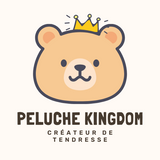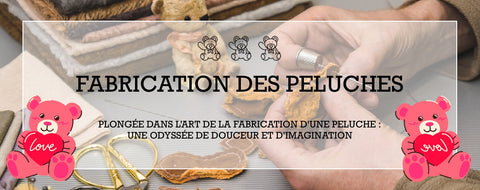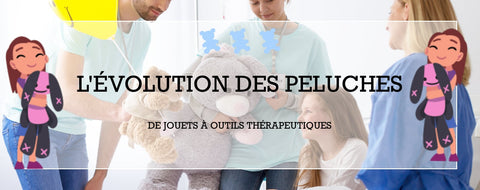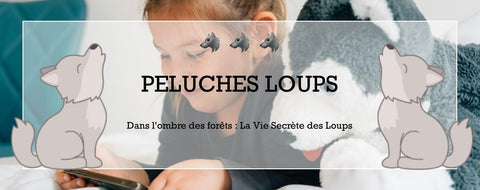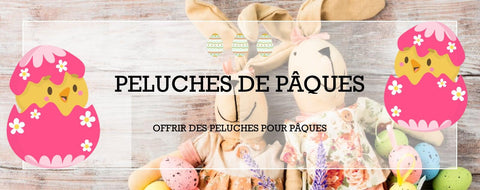
How to Choose a Safe Plush Toy for Your Baby?
of reading - words
Even though they are soft, cute 🥰 and cuddly, have you ever wondered What are plush toys made of? Here is a practical guide to help you choose your little one's toys wisely.
1) Why Choose Safer Soft Toys for Babies and Children?
Most children have a stuffed animal. You know, the one they carry everywhere, the one you bring back from where it was left so as not to risk disturbed sleep? For many children, their favorite stuffed animal matters more than anything in the world in their eyes. Even though these toys are cute, cuddly and adorable, have you ever wondered what they are made of or filled with?
Children spend a lot of time cuddling and sleeping with these toys. It is therefore good to get into the habit of checking what they are made of before buying new toys. Your kids could be exposed to some pretty nasty materials, including volatile organic compounds, flame retardants, and hormone-disrupting chemicals. Studies in recent years have revealed that many common toys may contain potentially harmful levels of lead, phthalates, brominated chemical flame retardants, heavy metals like cadmium and more. Not so cuddly after all!?

Choosing safe stuffed toys is therefore an important way to protect your baby . A toy approved ✅ for your baby's age group and without removable parts to prevent choking hazards is a good way to start choosing a safer stuffed toy. Also, always supervise your baby when playing with safe plush toys.
2) Inspect the Plush Toy
A- The Strings in Their Full Length
Make sure the toys don't have long strings〰. Babies are prone to wrapping long strings and ropes around their necks and choking. They can also swallow the string. To avoid these undesirable consequences, take a good look at the stuffed animal that you plan to give to your baby. Check the back of the toy for pulling strings that could make the stuffed animal say something or perform an action.

B- Removable Parts
Make sure toys have no moving parts. Removable parts are more common on sturdier plastic toys and action figures. But plush toys often have removable accessories like cups ☕ or glasses that can come off with Velcro, for example. Some toys even have special labels or price tags on them, which can be dangerous for your baby. Cut off these tags and any plastic or string holding them together. Check and carefully remove all removable parts of the toy which could become loose or broken and present a choking hazard.
If ever pieces come off a plush, don't try to fix it 🔧 . Instead, return the toy to the store and buy a safer stuffed toy. Do not try to replace it.

C- Batteries and Electricity
Be careful when giving a stuffed animal with batteries. Batteries pose a serious choking hazard to babies. If your baby wants a plush with batteries, make sure the batteries are secured by a panel which must be unscrewed 🔩 to be able to remove them. Do not give your child a stuffed toy with a battery panel that pops open. Although your baby is unlikely to be able to open the battery panel, it's not a risk worth taking.
If your baby's soft toy lights up, dances, or engages in some other action, it's powered ⚡ by batteries. You can also identify battery-powered toys thanks to the label on the package that says "battery powered".

Check battery-operated plush toys occasionally for check for acid leaks . Battery acid leaves a crusted, discolored area inside the battery panel. It can be brown or white in color. Discard leaky batteries, clean 🧼 the battery panel of the toy and insert new batteries.
D- The Pointed Horns of Goats
Avoid toys with sharp points, even plush or semi-plush toys sometimes have sharp points . For example, don't give your child a stuffed goat 🐐 with plastic horns sticking out of his head. Your baby could get the sharp horn stuck in his eye or hurt himself in a thousand other ways with it, which is obviously to be avoided!

Even fluff from a toy should be treated with suspicion. So avoid all soft toys that have sharp points 🗡 so that your child can have fun without danger.
E- Quality above all!
Make sure the toy is of high quality. When examining plush toys for safety, gently pull on their seams. If you feel that the toy is poorly sewn 🧵, do not buy it. Instead, look for soft toys that are durable and which do not tear easily. You can also exert light pressure on the plush toy and feel whether the toy looks good on you.

Plush toys bad quality are not sure for babies 👶. If they tear and the inside of the soft toy empties, your baby could eat it and choke.
Choose plush toys that can withstand chewing and other similar abuses that babies often like to do, especially when the growing teeth 🦷 tickle their jaw. Peluche Kingdom ® plush toys are obviously of good quality.

F- As Light as the Wind
Choose light fluff. Avoid, for example, giving your baby the giant stuffed gorilla you won at the fair. Soft toys that are too heavy are not safe for a baby. If a heavy stuffed animal fell, it could easily suffocate your baby. Except for the really giant stuffed animals, placed on the ground which serves as his secret cabin 🕵 where he likes to play and rest on it!
G- A Question of Age
Safe plush toys should have a label that informs parents of the age that a child must have to use the toy in question or if you purchased the plush online, this must be indicated in the description 📄 of the plush purchased. For example, you may find a stuffed animal whose packaging says "For ages 2 and up." This means that children under the age of two should not play with this plush. In this case, if your child is under two years old, look for a safer stuffed animal.

H- A Brand New Toy, A Healthy Child
Do not choose old toys. If an older relative offers to provide you with an older stuffed animal, Kindly decline the offer . Older plush toys may not meet current safety standards 👷♀ and, without the original packaging, you likely will have no way of knowing. Additionally, since they are handmade, they are more likely to tear at the seams.
3) Choose the Right Materials
A- ...hop, to the Machine
Choose washable materials 🚿. After regular use, your baby's soft toys will be very dirty. When choosing safe plush toys for your baby, you should make sure you can keep them clean . Check the care label or the back of the box the stuffed toy is packaged in for information about the material it is made of. Avoid buying plush toys that cannot be washed.

Non-washable (or unwashed) toys collect germs and bacteria. This presents a dangerous situation for the baby . To properly wash a stuffed toy, you can check out our complete guide to cleaning stuffed animals ✔ .
B- Avoiding Toxic Materials
Buy non-toxic plush toys. As your baby will surely put the soft toy in his mouth 👅 and will handle it endlessly, you must provide him non-toxic plush toys . You can check the manufacturer's box to see what ingredients go into a particular soft toy, but to be sure, you should buy soft toys from a distributor like Peluche Kingdom ® which only offers toys made from safe materials for your baby.

C- Flames and Stuffed Animals
Make sure the plush toy is flame resistant. When checking the care label or the box the plush is packaged in, look for confirmation that the toy is "flame resistant" or "fire retardant." It means that The toy will not easily catch fire . Plush toys that catch fire easily are not safe for babies. For example, all Peluche Kingdom ® products do not catch fire easily 📛, even if this is not necessarily specified on all the labels of all soft toys.
4) Ensure Baby's Safety During Games
A- More than just a glance
Watch your baby. Babies are very creative. Your baby may find a way to hurt himself or get into mischief with even the safest stuffed toys. This is why it is important to always supervise your child when playing with even the safest stuffed animal and never leave him alone in his crib 💫 with a stuffed animal. Don't leave your baby alone, even for a moment, while he is playing.

B- It Smells Clean!
Wash your baby's stuffed toys 🐰. Babies love to sneeze and drool on things, including their toys. Secure plush toys become gross after regular use. Wash stuffed toys regularly of your baby following the manufacturer's instructions. Wash any stuffed toys that fall on the floor or are visibly dirty.
Most stuffed animals come with a care label that provides washing and drying information. Read the information on the label 📝 to wash the toy properly. For properly wash a plush toy , you can consult our complete guide to cleaning soft toys with more than 5 different methods , you will inevitably find the most suitable method for the situation in which the soft toy is!

C- A tidy room and the turn is done
Help your baby store his stuffed animals safely. If your baby leaves stuffed animals lying around, they can cause other people to trip or fall. Help your baby learn from an early age to recognize the place of toys 🗳 once you no longer play with them.
For example, when your child is finished playing with their stuffed toys, say 🗣️: "It's time to clean up. Let's put our toys in the toy box." Place a stuffed toy in the trunk to toys. If your baby can walk, encourage him to do the same.

D- Ali Baba's Cave
Store stuffed animals in a trunk without a lid 🧺. If your baby has a toy box with a heavy lid, he could accidentally crush it on his little hands and injure himself. To avoid this misfortune, choose a chest without a lid . It will also make safe soft toys more accessible to your baby.
E- It's Bedtime
Don't allow your baby to take a soft toy into bed 🛏. Unless your baby no longer sleeps in his crib, no soft toy is safe in bed with your baby . With a stuffed animal even safely in his bed, your baby is at risk of danger.

Now that you know how to choose a safe soft toy for your baby, all you have to do is choose the stuffed animal that will please him 🤗 . To do this, you can see: How to choose the perfect soft toy for your child?
